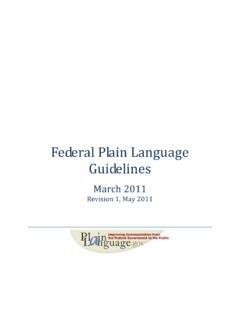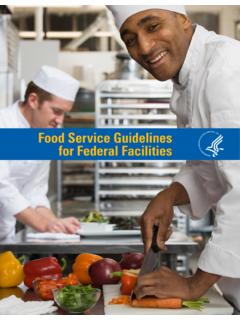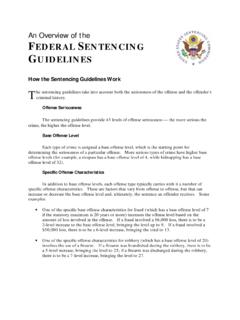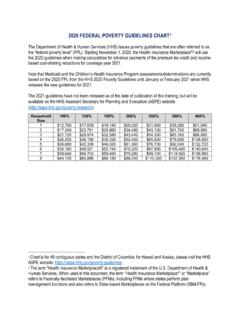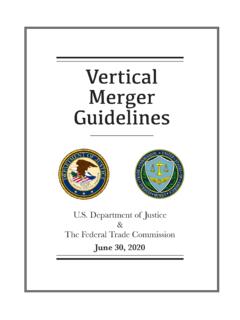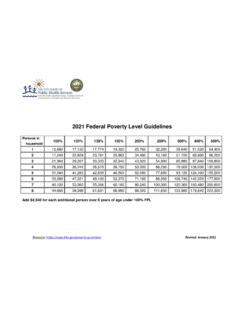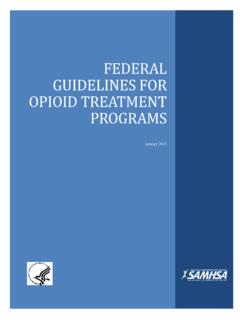Transcription of Federal Plain Language Guidelines
1 Federal Plain Language Guidelines March 2011 Revision 1, May 2011 Federal Plain Language Guidelines , March 2011, Rev. 1, May 2011 i Introduction The Plain Language Action and Information Network ( Plain ) is a community of Federal employees dedicated to the idea that citizens deserve clear communications from government. We first developed this document in the mid-90s. We continue to revise it every few years to provide updated advice on clear communication. We hope you find this document useful, and that it helps you improve your writing and your agency s writing so your users can: find what they need, understand what they find; and use what they find to meet their needs. We ve divided the document into five major topics, although many of the subtopics fit within more than one topic.
2 We start with a discussion of your audience because you should think about them before you start to write your document or your web content. In fact, you should start to think about them before you start to plan. From there we move to organization, because developing a good organization is important during your planning stage. Next, we discuss writing principles, starting at the word level and moving up through paragraphs and sections. This is the most extensive topic. We follow principles of writing documents with principles of writing for the web. We conclude with a short discussion of testing techniques. When we first wrote this document, we were primarily interested in regulations. We ve broadened our coverage, but the document still bears the stamp of its origin.
3 If you have a suggestion about something we should add to address other types of writing, or have a comment on this edition, contact us at Federal Plain Language Guidelines , March 2011, Rev. 1, May 2011 ii Revision 1 Changes We have not made any substantive changes in revision 1. We fixed the footer, corrected a few misspelled words, and modified our choice of words to be more concise. We made the formatting more consistent in Section V Test. We added a few more references to outside publications. And, we changed the file name of this document to make it more descriptive and user-friendly. Federal Plain Language Guidelines , March 2011, Rev. 1, May 2011 iii Table of Contents Introduction .. i Revision 1 Changes.
4 Ii Table of Contents .. iii I. Think about your audience .. 1 a. Identify and write for your audience .. 2 b. Address separate audiences separately .. 3 II. Organize .. 5 a. Organize to meet your readers needs .. 6 b. Address one person, not a group .. 10 c. Use lots of useful headings .. 11 d. Write short sections .. 15 III. Write your document .. 17 a. Words .. 18 1. Verbs .. 19 i. Use active voice .. 20 ii. Use the simplest form of a verb .. 22 iii. Avoid hidden verbs .. 23 iv. Use must to indicate requirements .. 25 v. Use contractions when appropriate .. 27 2. Nouns and pronouns .. 28 i. Don t turn verbs into nouns .. 29 ii. Use pronouns to speak directly to readers .. 30 iii. Minimize abbreviations .. 33 3. Other word issues.
5 35 i. Use short, simple words .. 36 ii. Omit unnecessary words .. 38 iii. Dealing with definitions .. 41 iv. Use the same term consistently for a specific thought or object .. 45 Federal Plain Language Guidelines , March 2011, Rev. 1, May 2011 iv v. Avoid legal, foreign, and technical jargon .. 46 vi. Don t use slashes .. 48 b. Sentences .. 49 1. Write short sentences .. 50 2. Keep subject, verb, and object close together .. 52 3. Avoid double negatives and exceptions to exceptions .. 54 4. Place the main idea before exceptions and conditions .. 56 5. Place words carefully .. 60 c. Paragraphs .. 62 1. Have a topic sentence .. 63 2. Use transition 64 3. Write short paragraphs .. 66 4. Cover only one topic in each paragraph.
6 68 d. Other aids to clarity .. 69 1. Use examples .. 70 2. Use lists .. 71 3. Use tables to make complex material easier to understand .. 74 4. Consider using illustrations .. 77 5. Use emphasis to highlight important concepts .. 82 6. Minimize cross-references .. 83 7. Design your document for easy reading .. 88 IV. Write for the web .. 89 a. How do people use the web? .. 90 b. Write for your users .. 92 c. Identify your users and their top tasks .. 93 d. Write web content .. 94 e. Repurpose print material for the web .. 95 f. Avoid PDF overload .. 96 g. Use Plain - Language techniques on the web .. 97 h. Avoid meaningless formal Language .. 98 Federal Plain Language Guidelines , March 2011, Rev. 1, May 2011 v i. Write effective links.
7 99 V. Test .. 100 a. Paraphrase Testing .. 102 b. Usability Testing .. 104 c. Controlled Comparative Studies .. 107 d. Testing Successes .. 109 1. Paraphrase Testing from the Veterans Benefits Administration .. 110 2. Usability Testing from the National Cancer 112 Federal Plain Language Guidelines , March 2011, Rev. 1, May 2011 1 I. Think about your audience One of the most popular Plain Language myths is that you have to dumb down your content so that everyone everywhere can read it. That s not true. The first rule of Plain Language is: write for your audience. Use Language your audience knows and feels comfortable with. Take your audience s current level of knowledge into account. Don t write for an 8th grade class if your audience is composed of PhD candidates, small business owners, working parents, or immigrants.
8 Only write for 8th graders if your audience is, in fact, an 8th grade class. Make sure you know who your audience is don t guess or assume. Federal Plain Language Guidelines , March 2011, Rev. 1, May 2011 2 a. Identify and write f or your audience You have to grab your audience s attention if you want to get your ideas across. Let s face it, people want to know just what applies to them. The best way to grab and hold someone s attention is to figure out who they are and what they want to know. Put yourself in their shoes; it will give you a new perspective. (Read Identify your users and their top tasks for more information.) Tell your audience why the material is important to them. Say, If you want a research grant, here s what you have to do.
9 Or, If you want to mine Federal coal, here s what you should know. Or, If you are planning a trip to Rwanda, read this first. Identifying your audience will do more than ensure that you write clearly. It will also help you focus on the audience s needs. Start out by thinking about what your audience knows about the situation now. Then, think about how to guide them from their current knowledge to what you need them to know. To help you do this, try answering the following questions: Who is my audience? What does my audience already know about the subject? What does my audience need to know? What questions will my audience have? What s the best outcome for my agency? What do I need to say to get this outcome? What s the best outcome for our audience?
10 What do I need to say to get this outcome? Sources Garner, Bryan A., Legal Writing in Plain English, 2001, University of Chicago Press, Chicago, pp. 93-96. Securities and Exchange Commission, Plain English Handbook, 1998, Washington, DC, p. 9. Federal Plain Language Guidelines , March 2011, Rev. 1, May 2011 3 b. Address separate audiences separately An important part of writing for your audience is addressing separate audiences separately. Many documents address more than one audience. Documents that mix material intended for different audiences may confuse readers. By addressing different audiences in the same place, you make it harder for each audience to find the material that applies to them. In regulations, this may make it difficult for each audience to comply with your agency s requirements.
